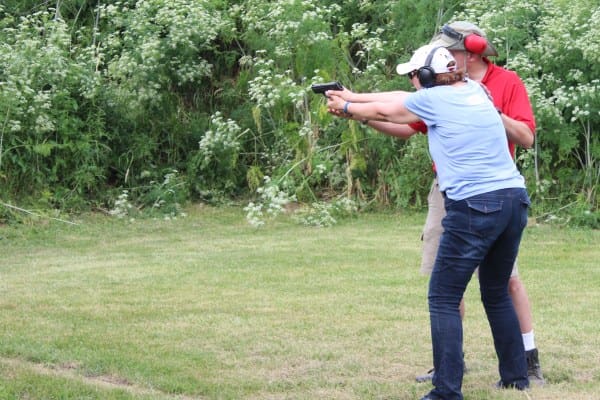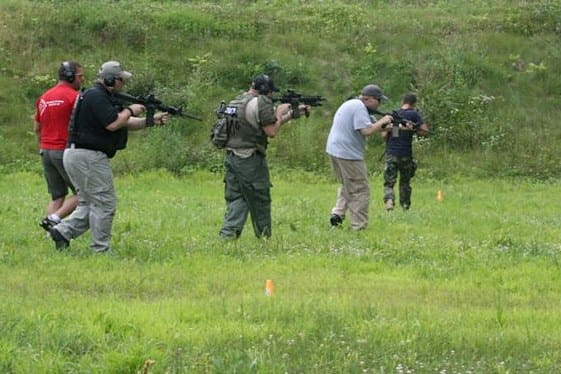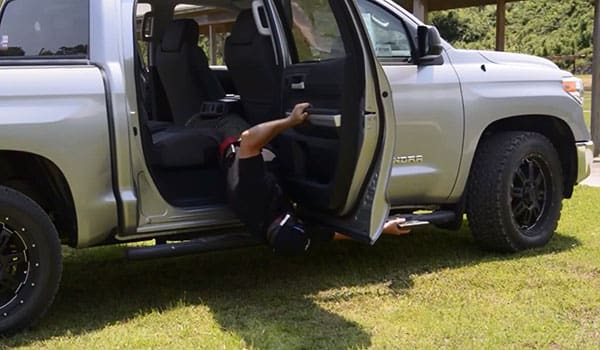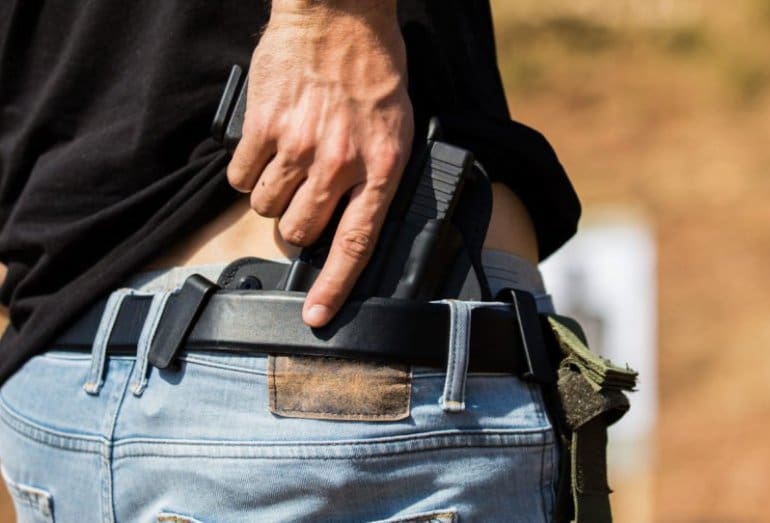Carrying a gun lawfully for self-defense can make the difference between life and death in a critical situation. Yet at the same time it comes along with risks to the carrier thanks to laws and land sharks. Training can help reduce those risks dramatically.
In a perfect world (and most states), you wouldn’t need a license to carry or training in the effective use of a firearm for self-defense. Unfortunately, the world isn’t perfect and neither are we.
In the real world, mistakes happen. All it takes is a single moment of oversight, sloppy gun handling or lousy gear and you can find yourself jammed up and wearing handcuffs. Heaven help you if you have a negligent discharge or make a mistake in judgement about when to pull your gun. Make those kinds of mistakes and you risk everything, including prison.
With good training, the risks attendant with carrying and using a firearm for self-defense are greatly diminished. You’ll become an expert at gun safety and can share those skills with your family and others to make them experts at safety as well. You’ll also learn better situational awareness.
The right training will teach you body language and behaviors that will make you less likely to be “selected” for victimization by bad guys. Best of all, your odds of prevailing in a deadly force encounter will be significantly enhanced. But remember . . .

All Training Isn’t Equal
With the growing numbers of new gun owners across America, many people are looking for classes, especially those who also want to apply for a carry license. These concealed carry classes tend to be plentiful where required, and are often conducted by National Rifle Association-certified instructors. Classes run the gamut from borderline incompetent to barely adequate to well-presented, comprehensive learning programs.
As an example, in Illinois a year before right-to-carry was passed, there were approximately 42 NRA instructors who had taught ten or more people the previous year. Today, we have over 3000 Illinois State Police-approved instructors.
Beyond learning the basics from an introduction to concealed carry class, there are other programs out there for people looking for basic gun safety skills or to make themselves better shooters…everything from competition and marksmanship to hunting and self-defense.
When it comes to self-defense firearms training, easily the most common are those designed to teach self-defense fundamentals. The best of these “save your bacon” courses will incorporate all three of the following:
Mindset
Mindset is the knowledge and attitudes needed to avoid and, if necessary, survive a confrontation. This includes the mental preparation for dealing with all aspects of a violent encounter at home or in public…and to never give up in a fight for your life.
This particular aspect of training emphasizes conflict avoidance, layering your defenses, and knowing the legal standard by which you will be judged for using lethal force against another. A well-taught class will help you avoid trouble through situational awareness and conflict de-escalation, and also keep you out of jail for inappropriately introducing a weapon – firearm or otherwise – into a situation.
Functional ability/training
Functional ability training consists of knowing how to make your gun work, the ability to use it safely and effectively, and the associated aspects of your gun’s proper care and feeding.
Any reputable course will inculcate you with basic firearm safety. Exercising proper muzzle discipline and keeping your finger off the trigger until you have decided to shoot should be as natural as breathing. Sadly, for those without formal training, poor muzzle control and trigger finger discipline are the norm.
Gun selection plays an important role as well. Some folks may have compatibility issues with a gun they like, making it a bad choice for them. If you can’t manipulate your preferred gun, then you should find another one. Arthritis, hand strength, or other physical limitations are common causes for these issues, but so are a lack of familiarity with a firearm’s controls.
Good schools will steer you away from poor gun choices without making fun of what you may already have. Just because you thought the Beretta 92 looked really cool in Lethal Weapon doesn’t mean it’s a good carry choice for you.

Tactical training
Tactical is not “tacticool” where people dress up in tactical bro gear and pretend they’re something they aren’t. Instead, it’s the practical, hands-on study of the tactics needed to avoid conflict or, failing that, to fight with your personal defense tools.
This includes learning the effective use of cover and concealment, proper presentation of the gun, situational awareness, proper force “application” strategies, malfunction clearing procedures, reloading techniques and so much more.
Reading a book or watching a video helps and can serve to introduce these concepts, but there’s no substitute for doing it yourself under the tutelage of a skilled instructor who will ensure you’re using good technique and minimizing wasted movement. This allows you to act quickly and decisively, without “thinking” about the mechanics of what you’re going to do once you’ve decided to act.
The old saw that ‘you don’t rise to the occasion, you fall to your level of training’ is pretty much true. Indecisiveness, wasted motion and/or poor skills seldom win competitions or gun battles.
Finding a good course
Better, more enjoyable courses will share many common attributes. Here’s how to find for them and some attributes to seek out.
Research the instructor/school. Start with their website. Pictures will often tell the tale of how many people they’re training and how they do it. Is poor muzzle control or other questionable safety issues shown in the pictures? I’ve seen images of everything from people shooting inside a pole barn without proper ventilation to people walking in front of other shooters on an open range. If it’s the same three “students” in all of the photos, that’s a clue. If there are no photos, that should be a clue as well. No website? Why not?

Call and talk with them. Speak with the instructor ahead of giving them your money. Ask them any questions you might still have…anything from describing their previous experience, to inquiring about accommodations for those less-mobile or otherwise disabled. Ask them about how many instructors will be present and the expected ratio of staff to students. Ask them why they became a firearms instructor. Good teachers should have good answers for your questions.
Look for experienced instructors. While everyone has to start somewhere, previous instructional experience measured in years — not months — will usually lead to a better end result for you, the consumer/student. If prospective instructors try to dazzle you with their experience in the Boy Scouts, ROTC, or “personal interest,” look out.
Look for instructors who have continued their education especially if they’ve been to some of the nationally-known schools. They will most likely bring lessons and techniques they’ve learned from the nationally-respected masters to your local class.
Instructors who carry Do the instructors themselves carry every day, or are they just teaching theoretical concepts to their students?
“Team teaching” is a good thing, as instructors can teach to their strengths and students enjoy hearing a more diverse set of perspectives. The end result is usually a better educational experience for the students.
A team of instructors also offers greater opportunities for the student to get more one-on-one help as needed, particularly on the firing line during live fire or in other practical aspects of the class.

Previous law enforcement or military instructional experience is a bonus. Again, it’s about bringing applicable aspects of the latest tactics to the class. I’ve been teaching for two decades and seen first-hand that “military” and “police” listed in someone’s credentials, while a net positive, doesn’t necessarily mean a lot when it comes to teaching new skills to new shooters.
Your class isn’t (or shouldn’t be) a boot camp or police academy. What matters is instructors’ ability to communicate with everyday people, teaching and empowering them with the skill sets they need to avoid becoming a statistic in the real world.

High instructor-to-student ratios. I can’t stress this one enough, especially for range exercises. If you have one or two instructors trying to run a range with ten or twelve entry-level students on the firing line at once, you’re getting badly short-changed as a student and it’s not as safe as it could be.
Ability to communicate with everyday people outside of the gun culture. Do schools try not to use jargon and are they willing to spend that extra time (and do they have the staff to do so) to work with new shooters, including women and children? Are they there for those who are a little slow at absorbing the subject material?
This one’s harder to assess outside of personal referrals or recommendations, but it’s especially important if you’re a novice, the lone woman in the class or you’re bringing your kids.
Courses that offer more than the minimum. Good instructors won’t cut corners, but in fact will supplement the minimum required material with valuable and useful (not to mention life-saving) information they’ve learned from other schools or instructors.
Loaner gun availability. Do they have loaner guns for folks who come with inappropriate or malfunctioning firearms, especially for basic firearm/home defense/CCW-type courses?
Sometimes they might even have an armorer on staff, but usually just having a loaner gun and gear (holster, ammo pouches, etc.) will be very helpful. You might have to pay a nominal fee, but loaner availability is a big plus.
Referrals, testimonials, and word of mouth are all things to look for in reputable, experienced instructors. Ask your friends who have been to a class what they thought of it. Visit your local gun club or gun rights organization and ask those present for recommendations on instructors and/or classes.
Red flags
With booming gun sales and more demand for firearm training, there are a lot of instructors — especially newly-minted ones — who vary significantly in skill, ability, and ethics. There are some red flags you can look for in entry-level training to help you avoid a disappointing experience.
Unsafe gun handling: Do instructors demonstrate safe gun handling or do they routinely put their cotton pickin’ finger on the bang switch inappropriately? Are they careless about muzzle control or are there not enough of them to police muzzle discipline of untrained/careless students?

Even worse, do they stand downrange while students are shooting or handling their guns? If you see any of this, the first step is to bring those concerns to the staff. If these problems go unaddressed, it might be a good time to pack your bag and walk. Training-related accidents are very rare, but if those running classes are lackadaisical about safety, it’s time to make yourself scarce.
Internet classes: Do instructors attempt to “teach” the classroom segments of the class via the internet? In general, that’s sub-optimal. Given social distancing and limits on the number of people in indoor spaces, that may be done more frequently these days.
Cost: Expect to pay a little more for experienced instructors with solid reputations or classes in big cities where range space is at a premium. But any course that’s advertised for dramatically less than the normal market rate for similar training from similarly-credentialed instructors is a big red flag.
Example: If a hypothetical CCW class goes for $200-250 at most locations and someone’s advertising theirs for $50, beware. Find out why it falls so far outside the norm.
Charging for free items like license application packets: One firearms training group in Illinois charged students $20 each for Florida and Arizona license application packets, even when those respective states send them out to anyone for free.
Cutting corners to do less than the minimum requirements: If it’s supposed to be an eight-hour class and the instructor finishes in six hours, that’s not good. In fact, it may constitute fraud in state-mandated CCW classes depending on local laws.
“Instructors” who haven’t had training: If the only formal training your prospective instructor has had was their “instructor certification” class, that’s cause for concern. Good firearm handling skills and knowledge of self-defense, personal protection, and the judicious use of deadly force don’t come from on high. They are learned.
Instructors teaching flawed, out-of-date or just plain unsafe information: That could get students killed or injured, either from tactical or a safety perspective. Example: “You should carry your gun with an empty chamber and rack the slide on your pants.”
Courses that are unrealistic: Do they teach you to hang upside down out of a pickup truck, firing one-handed under the door? Do they teach you barrel rolls while you hold your gun? Pack your gear and run. Worry about a refund later.

Things you can do to make your training experience better
- Come bright-eyed and bushy-tailed. Get a good night’s rest. Leave the drinking and nightlife alone the night before.
- Come with an open mind. Leave preconceived notions behind along with your man-card if you’re a guy. If they teach you something new, try it. You can always discard it later.
- Dress appropriately. Wear closed-toe shoes, long pants with a belt, and bring along a baseball cap or similar. Ladies, leave the low-cut shirts at home. Also bring rain gear or extra clothing for unseasonably cool weather.
- Bring your own eye and ear protection. Bring sunscreen and bug spray, just in case.
- Hydration should be provided by the class sponsors. Hydration is a safety issue, but bring some of your own just in case. Avoid caffeine as it contributes to dehydration.
- Bring lunch, as necessary along with any medications or other personal needs.
- Bring your gun, gear and the required amount of ammunition, minimum. Check your gun and gear before the class. If a family of dust bunnies has taken residence in the barrel, clean it. If it’s filthy, clean it. If your ammo dates from the Spanish-American War era, looks corroded, or the lead has turned white, buy new ammo.
- Bring a backup gun in case your front-line gear goes down, especially for intermediate and advanced classes where you expect to shoot a lot. Ditto for any gear you know you’ll need.
- For rifle classes (or if you have a fancy optic on your pistol), come to class sighted in. Bring spare batteries for your holographic sights and a sling for your long gun.
- Bring a notepad and pens.
- Read the recommended gear list and follow those instructions.
- Turn your phone off or on completely silent mode before class starts.
- Everyone’s a range safety officer. If you see someone doing something unsafe, ask them to stop. Report any safety concerns to the instructor(s) right away.
- Address any concerns or questions you might have privately before class or during breaks where possible. Don’t tie up class time.
Do your own research
There’s no need to settle to waste your hard-earned money on a course that will disappoint you. Use the information contained here to help guide your course selection. It’s not that difficult to find training that meets or exceeds your needs instead of settling for a marginal offering that falls short.
Life is precious, training is cheap
Remember, training is inexpensive compared to your life and the lives of your loved ones, so it’s not a place to cut corners. Good training that allows you to avoid becoming a victim and come out on top is truly priceless in the long run.










